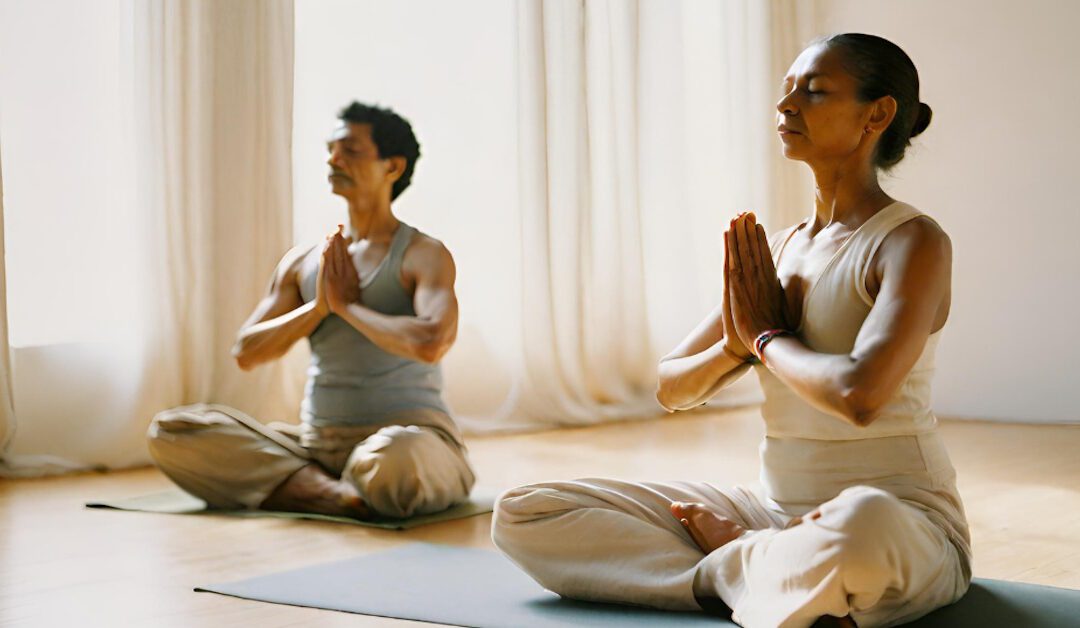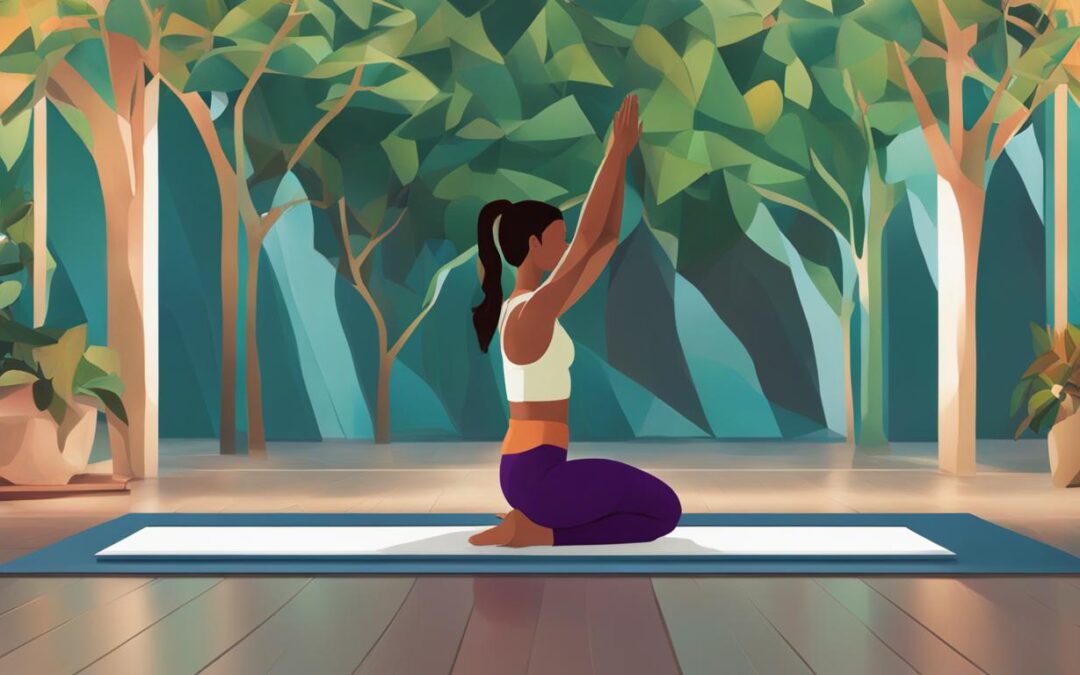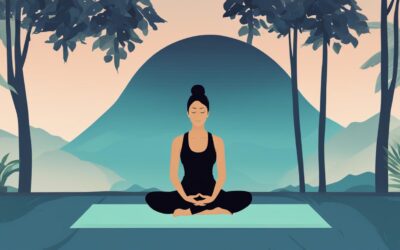Are you looking for effective ways to relieve stress and find peace? Discover the power of yoga for stress relief and learn how it can help you reduce stress and bring harmony into your life.
Yoga is a powerful method for reducing stress and finding inner peace. It activates the body’s relaxation response, lowers blood pressure, and reduces stress hormones. By practicing yoga, you can restore balance in a hectic day and find solace in the present moment.
Understanding the Benefits of Yoga for Stress Relief
Yoga offers numerous benefits for stress relief, including activating the body’s relaxation response, lowering blood pressure, and reducing stress hormones. By incorporating yoga for mental relaxation and stress relief into your daily routine, you can experience a sense of calm and inner peace.
One of the primary benefits of yoga for stress relief is its ability to activate the body’s relaxation response. Through deep breathing, gentle movements, and mindful awareness, yoga helps to calm the nervous system and promote a state of relaxation. This, in turn, can lower blood pressure and reduce the release of stress hormones such as cortisol.
Additionally, practicing yoga can help increase self-awareness and promote overall well-being. The gentle asanas (poses), such as Child’s Pose and Standing Forward Bend, encourage physical release and relaxation. Combined with pranayama (breathing exercises) like Ujjayi breath and Alternate Nostril Breathing, these techniques can help reduce anxiety and promote mental clarity.
Mindfulness and meditation practices also play a crucial role in yoga for stress relief. By focusing on the present moment and cultivating awareness, yoga helps to quiet the mind and reduce stress and anxiety. Practices like Surya Namaskar (Sun Salutation), Sthiti Dhyan (Observation Meditation), and Khand Pranayama (Segmented Breath) can enhance mindfulness and improve your ability to manage stress in daily life.
| Gentle Asanas for Stress Relief | Pranayama for Stress Relief | Meditation and Mindfulness Practices |
|---|---|---|
| Child’s Pose | Ujjayi breath | Surya Namaskar (Sun Salutation) |
| Standing Forward Bend | Alternate Nostril Breathing | Sthiti Dhyan (Observation Meditation) |
| Khand Pranayama (Segmented Breath) |
Key Takeaways:
- Yoga is an effective technique for reducing stress and finding inner peace.
- It activates the body’s relaxation response and lowers blood pressure.
- Gentle asanas, pranayama, yoga nidra, and meditation are essential yoga techniques for stress relief.
- Yoga helps cultivate mindfulness and focus, enhancing overall well-being.
- By customizing your yoga routine and incorporating it into your daily life, you can experience the benefits of stress relief and inner peace.
Customizing your yoga routine to incorporate these techniques can help you effectively manage stress and cultivate a sense of inner peace. Remember, finding a balance and adapting the practice to your individual needs and preferences is key. Embrace the power of yoga for stress relief and discover a path to greater well-being and serenity.

Explore these essential yoga techniques that can help you find relief from stress and restore balance to your mind and body. Yoga is a powerful method for reducing stress and finding inner peace. By incorporating these techniques into your practice, you can experience the transformative benefits of yoga for stress relief.
One of the key aspects of stress relief yoga is gentle asanas (poses) that promote relaxation and release tension in the body. Some examples of these poses include Child’s Pose and Standing Forward Bend. Child’s Pose, also known as Balasana, is a restful pose that helps to calm the mind and relax the body. To perform this pose, start by kneeling on the floor, then sit back on your heels and fold your upper body forward, extending your arms out in front of you. Allow your forehead to rest on the floor and take deep breaths, focusing on the sensation of releasing stress with each exhalation.
| Yoga Pose | Benefits |
|---|---|
| Child’s Pose (Balasana) | Calms the mind and releases tension in the body. |
| Standing Forward Bend (Uttanasana) | Relieves stress and anxiety, stretches the hamstrings, and promotes relaxation. |
In addition to asanas, pranayama (breathing exercises) is another essential component of stress relief yoga. One technique that is particularly effective is Ujjayi breath. Ujjayi breath involves inhaling and exhaling slowly through the nose while constricting the back of the throat, creating a gentle hissing sound. This deep breathing technique helps to calm the nervous system, reduce anxiety, and promote a sense of relaxation.
Meditation and mindfulness practices are also integral to stress relief yoga. These techniques help to cultivate awareness, focus, and present-moment awareness. Sthiti Dhyan (Observation Meditation) is a powerful practice that involves observing the breath, thoughts, and sensations without judgment. Another technique, Khand Pranayama (Segmented Breath), focuses on lengthening the exhale to activate the body’s relaxation response. By incorporating meditation and mindfulness into your yoga practice, you can enhance your ability to manage stress and find inner peace.
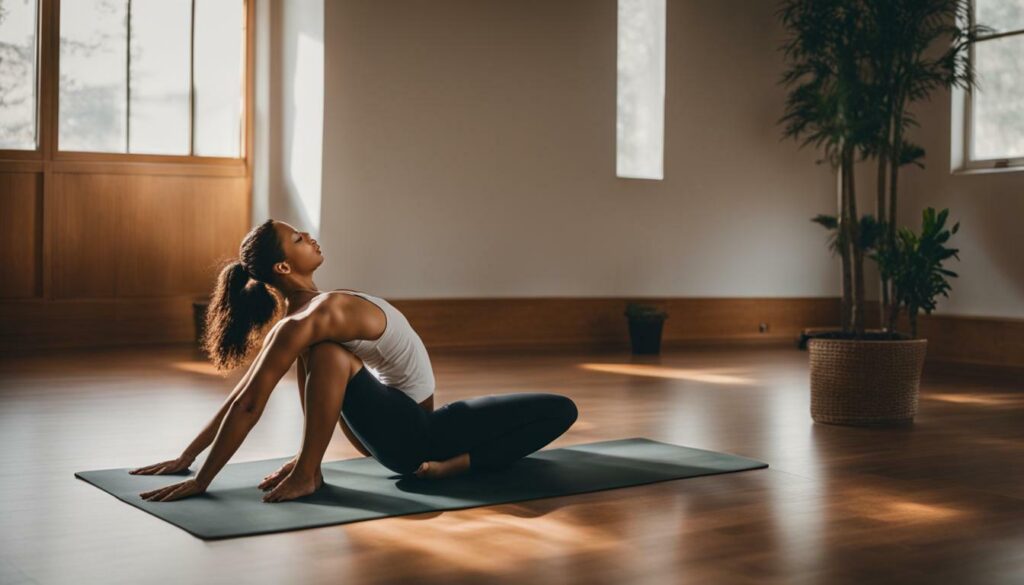
- Gentle asanas like Child’s Pose and Standing Forward Bend promote relaxation and release tension in the body.
- Pranayama techniques, such as Ujjayi breath, help to calm the nervous system and reduce anxiety.
- Meditation and mindfulness practices, like Sthiti Dhyan and Khand Pranayama, cultivate awareness and present-moment focus.
By incorporating these essential yoga techniques into your practice, you can effectively reduce stress, find relief, and restore balance to your mind and body.
Cultivating Mindfulness and Focus Through Yoga
Discover how yoga can help you cultivate mindfulness, improve focus, and effectively manage stress and anxiety. Yoga is not just a physical practice; it is a holistic approach to achieving balance and tranquility in both the body and mind. By combining gentle asanas, pranayama, meditation, and mindfulness practices, you can transform your yoga practice into a powerful tool for stress relief and self-discovery.
One of the key benefits of yoga is its ability to keep you in the present moment. In today’s fast-paced world, it’s easy to get caught up in worries about the future or dwelling on past events. Yoga teaches you to focus on the here and now, allowing you to let go of stress and anxiety. Through the practice of asanas, such as Surya Namaskar (Sun Salutation), you can synchronize your breath with movement, creating a state of flow that helps quiet the mind and sharpen your concentration.
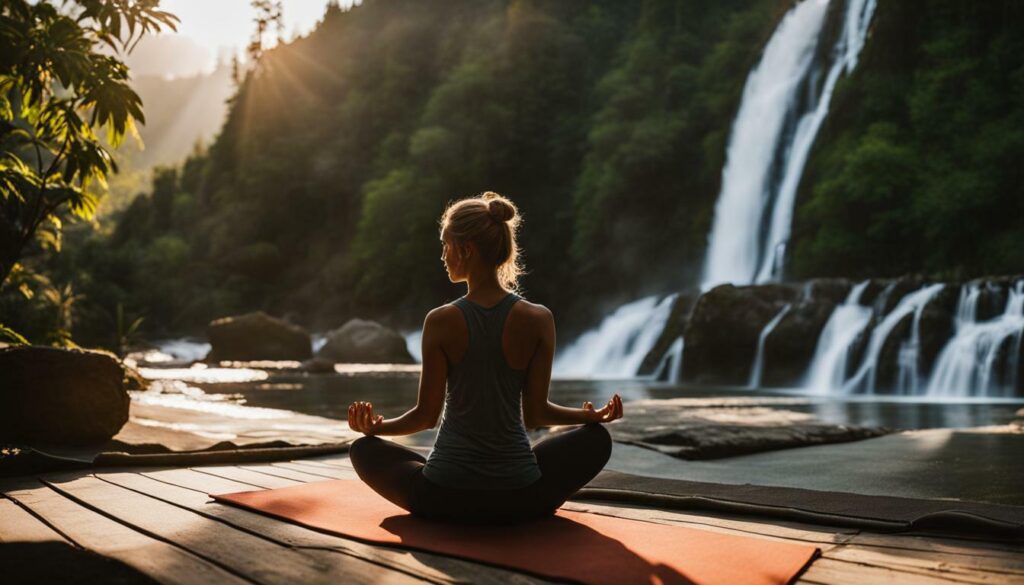
In addition to physical postures, incorporating meditation techniques, like Sthiti Dhyan (Observation Meditation), can enhance your mindfulness practice. This form of meditation involves observing your thoughts, feelings, and bodily sensations without judgment. It allows you to gain insight into your inner world and develop a greater sense of self-awareness. Another technique is Khand Pranayama (Segmented Breath), which involves focusing on different segments of the breath to awaken the senses and increase mental clarity.
| Yoga Practice | Benefits |
|---|---|
| Child’s Pose | Relaxes the body, calms the mind, and releases tension in the back and shoulders. |
| Standing Forward Bend | Stretches the hamstrings and spine, encourages deep breathing, and promotes a sense of calm. |
| Ujjayi Breath | Calms the nervous system, regulates the breath, and focuses the mind. |
| Alternate Nostril Breathing | Balances the energy channels in the body, reduces stress, and improves mental clarity. |
Through these various yoga practices, you can create a harmonious and balanced state of being. Regularly incorporating yoga into your daily routine allows you to reap the long-term benefits of stress relief, improved focus, and enhanced overall well-being. Remember to listen to your body, honor your limitations, and practice with patience and self-compassion.
Customizing Your Yoga Routine for Stress Relief
Learn how to customize your yoga routine to effectively reduce stress, promote mental relaxation, and find inner peace. Yoga is a versatile practice that can be tailored to suit your individual needs and preferences. By incorporating specific techniques and poses, you can enhance the stress-relieving benefits of yoga and create a personalized routine that works best for you.
Start by selecting gentle asanas, such as Child’s Pose and Standing Forward Bend. These poses promote deep relaxation and help release tension in the body. Practice them with slow, mindful movements, focusing on your breath and allowing yourself to let go of stress and worries.
In addition to asanas, include pranayama (breathing exercises) in your routine. Ujjayi breath and Alternate Nostril Breathing are great techniques for reducing stress and calming the mind. These breathing exercises help regulate the flow of energy in the body and promote a sense of balance and tranquility.
| Asanas (Poses) | Benefits |
|---|---|
| Child’s Pose | Relieves tension in the back, neck, and shoulders; calms the mind |
| Standing Forward Bend | Stretches the hamstrings and releases tension in the spine; improves blood circulation |
Yoga nidra, also known as yogic sleep, is another powerful technique for stress relief. It involves deep relaxation and guided meditation, allowing you to enter a state of profound rest and rejuvenation. Incorporate yoga nidra into your routine by finding a quiet, comfortable space where you can lie down and follow a guided meditation or visualization.
To cultivate mindfulness and focus, incorporate specific yoga practices into your routine. Surya Namaskar (Sun Salutation) is a dynamic series of poses that combines movement, breath, and meditation. It helps invigorate the body and mind while promoting a sense of presence and awareness.
Quote:
“Yoga is not about touching your toes, it’s about what you learn on the way down.” – Judith Hanson Lasater
Sthiti Dhyan (Observation Meditation) is another practice that enhances mindfulness. It involves observing the sensations, thoughts, and emotions that arise during meditation without judgment or attachment. By developing the ability to observe your experiences with a sense of detachment, you can cultivate a state of calmness and resilience in the face of stress.
Incorporating yoga into your daily routine is key to reaping the benefits of stress relief and finding inner peace. Experiment with different poses, techniques, and durations to discover what works best for you. Remember to listen to your body and practice with patience and compassion. With consistency and dedication, you can create a yoga routine that supports your overall well-being and helps you navigate through life’s challenges with grace.
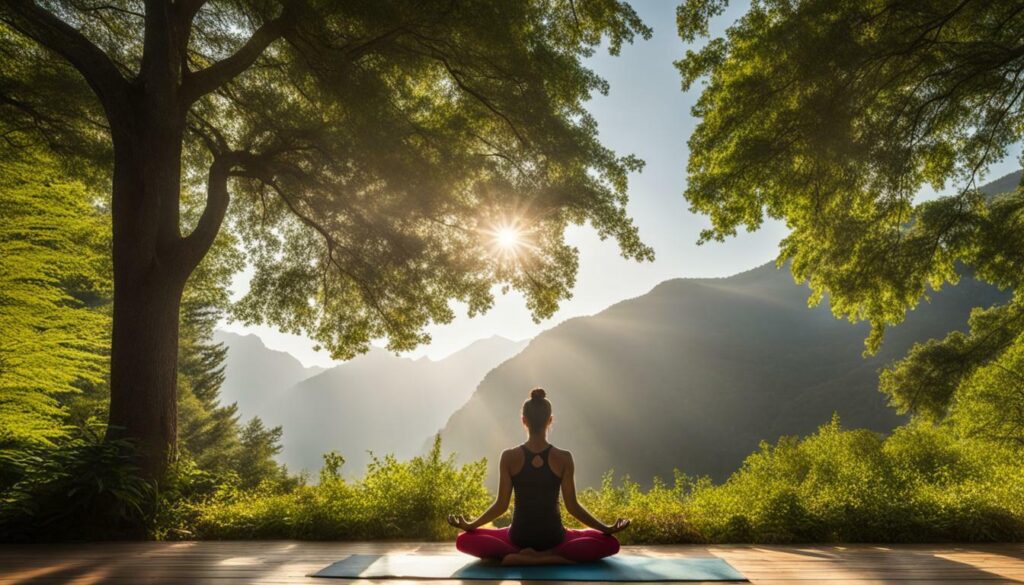
Discover expert-guided techniques and valuable tips for using yoga as a powerful tool to alleviate stress and promote overall well-being. Yoga is a holistic practice that combines physical movement, breath control, and mindfulness to create a state of relaxation and inner peace. By incorporating these expert-guided techniques into your yoga routine, you can experience the many benefits of stress relief and enhanced well-being.
One important aspect of yoga for stress relief is the practice of gentle asanas. These poses help release tension in the body and create a sense of relaxation. Some recommended asanas for stress relief include Child’s Pose, which gently stretches the back and hips, and Standing Forward Bend, which helps decompress the spine and calm the mind. By practicing these poses mindfully and focusing on your breath, you can bring your attention inward and find a sense of calm.
In addition to asanas, incorporating pranayama, or breath control exercises, into your yoga practice can further enhance stress relief. Ujjayi breath, also known as Ocean Breath, involves breathing in and out through the nose while slightly constricting the back of the throat.
This deep, calming breath helps activate the body’s relaxation response and promotes a sense of tranquility. Another beneficial pranayama technique is Alternate Nostril Breathing, which involves inhaling through one nostril and exhaling through the other. This practice helps balance the nervous system and promotes a sense of inner harmony.
“Yoga is the journey of the self, through the self, to the self.” – The Bhagavad Gita
Yoga nidra, also known as yogic sleep, is another powerful technique for stress relief. This practice involves lying down in a comfortable position and systematically guiding your awareness through different parts of the body. By cultivating a deep state of relaxation and conscious awareness, yoga nidra helps release tension and rejuvenate the mind and body.
Meditation and mindfulness practices are also integral to a stress relief yoga routine. By focusing your attention on the present moment and observing your thoughts and sensations without judgment, you can cultivate a sense of inner peace and reduce stress and anxiety.
Specific meditation practices like Sthiti Dhyan, or Observation Meditation, and Khand Pranayama, or Segmented Breath, can be incorporated into your yoga practice to enhance mindfulness and deepen your connection with the present moment.

| Yoga Techniques for Stress Relief | Benefits |
|---|---|
| Child’s Pose | Relaxes the back and hips, calms the mind |
| Standing Forward Bend | Decompresses the spine, promotes relaxation |
| Ujjayi breath | Activates the body’s relaxation response, promotes tranquility |
| Alternate Nostril Breathing | Balance the nervous system, enhances inner harmony |
| Yoga Nidra | Releases tension, rejuvenates the mind and body |
| Sthiti Dhyan | Cultivates mindfulness, enhances present moment awareness |
| Khand Pranayama | Deepens connection with the present moment, promotes inner peace |
The Connection Between Yoga and Stress Management
Understand the profound connection between yoga and stress management and how regular practice can empower you to better cope with everyday challenges. Yoga is a powerful method for reducing stress and finding inner peace.
By engaging in yoga practices, you can activate your body’s relaxation response, lower blood pressure, and reduce stress hormones, allowing you to experience a sense of calm and overall well-being.
One of the key benefits of yoga for stress relief is its ability to cultivate mindfulness and focus. Through yoga, you learn to stay present in the moment, bringing your attention to the sensations in your body and the rhythm of your breath. This heightened awareness helps manage stress and anxiety, allowing you to approach challenges with greater clarity and resilience.
The Therapeutic Benefits of Yoga for Stress Relief
Yoga keeps you in the present moment and helps manage stress and anxiety.
Specific yoga practices can enhance mindfulness and further support stress management. Surya Namaskar (Sun Salutation) is a dynamic sequence of poses that combines movement and breath, providing a complete body-mind workout.
Sthiti Dhyan (Observation Meditation) encourages you to observe your thoughts and emotions without judgment, fostering a sense of inner calm. Khand Pranayama (Segmented Breath) involves alternating between inhaling and exhaling in short segments, promoting deep relaxation and regulating the nervous system.
By incorporating yoga into your daily routine and customizing it to your preferences and needs, you can experience the benefits of stress relief and inner peace. Whether you choose to practice gentle asanas, engage in pranayama and meditation, or explore mindfulness techniques, yoga offers a holistic approach to managing stress and cultivating well-being.
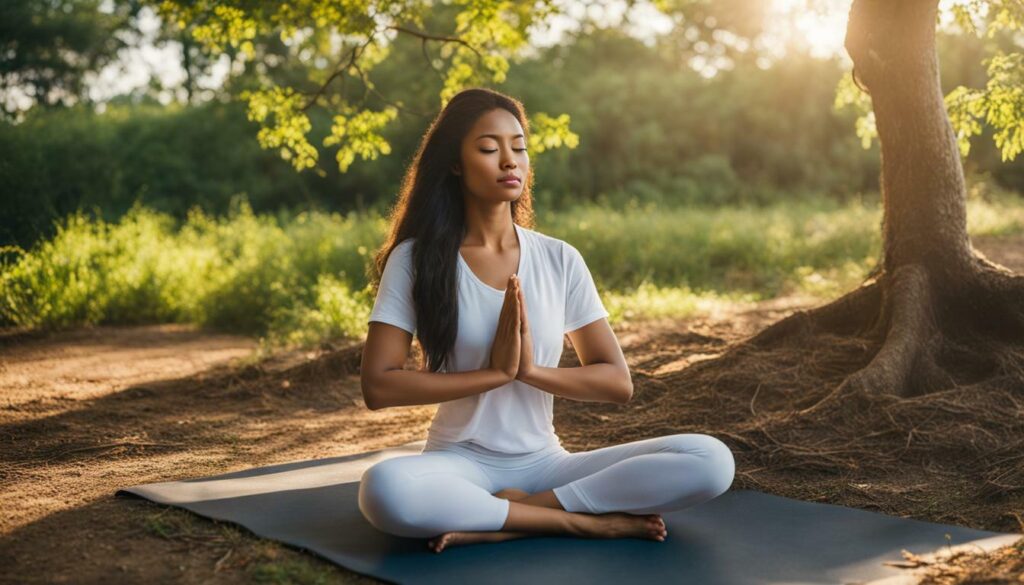
| Benefits of Yoga for Stress Relief | How Yoga Can Help |
|---|---|
| Reduces stress hormones | Yoga activates the body’s relaxation response, lowering the levels of stress hormones such as cortisol. |
| Lowers blood pressure | Regular yoga practice has been shown to decrease blood pressure, which is often elevated during times of stress. |
| Promotes mindfulness | Yoga helps cultivate mindfulness, allowing you to stay present in the moment and better manage stress and anxiety. |
| Enhances resilience | Through regular practice, yoga strengthens your coping mechanisms, helping you develop resilience to external stressors. |
| Improves focus | Yoga improves your ability to concentrate and focus, enabling you to navigate daily challenges with greater clarity. |
Incorporating Yoga Into Your Daily Routine
Discover how to seamlessly integrate yoga into your daily routine and make it a regular practice for reducing stress and promoting overall well-being. Yoga has been proven to be a powerful tool for stress relief, offering a wide range of benefits for the mind, body, and soul. By incorporating yoga into your daily routine, you can experience the transformative power of this ancient practice in your everyday life.
One of the keys to successfully integrating yoga into your daily routine is consistency. Set aside a specific time each day for your yoga practice, whether it’s in the morning, during a lunch break, or in the evening. Creating a regular schedule will help you establish a habit and ensure that you prioritize your well-being. Find a quiet and peaceful space in your home where you can practice without distractions.
Start your yoga practice with a few moments of mindfulness and deep breathing. Close your eyes and focus on your breath, inhaling and exhaling deeply. This will help center your mind and prepare you for the physical practice ahead.
Begin with gentle asanas that promote relaxation and release tension in the body, such as Child’s Pose and Standing Forward Bend. These poses help calm the nervous system and restore balance.
| Benefits of Incorporating Yoga Into Your Daily Routine |
|---|
| Reduced stress levels |
| Improved flexibility and strength |
| Enhanced mental clarity and focus |
| Increased energy and vitality |
| Better sleep quality |
As you progress in your practice, you can gradually incorporate more challenging asanas and explore different styles of yoga. Experiment with different sequences and find what resonates with you.
Don’t be afraid to customize your practice to suit your needs and preferences. You may also consider attending yoga classes or workshops led by experienced teachers who can guide you in your journey.
Remember that yoga is not just about the physical postures; it is a holistic practice that encompasses breathwork, meditation, and mindfulness. Dedicate time to pranayama (breathing exercises) like Ujjayi breath and Alternate Nostril Breathing to calm the mind and balance your energy. Set aside a few minutes for meditation and observe the sensations in your body and the thoughts in your mind without judgment.
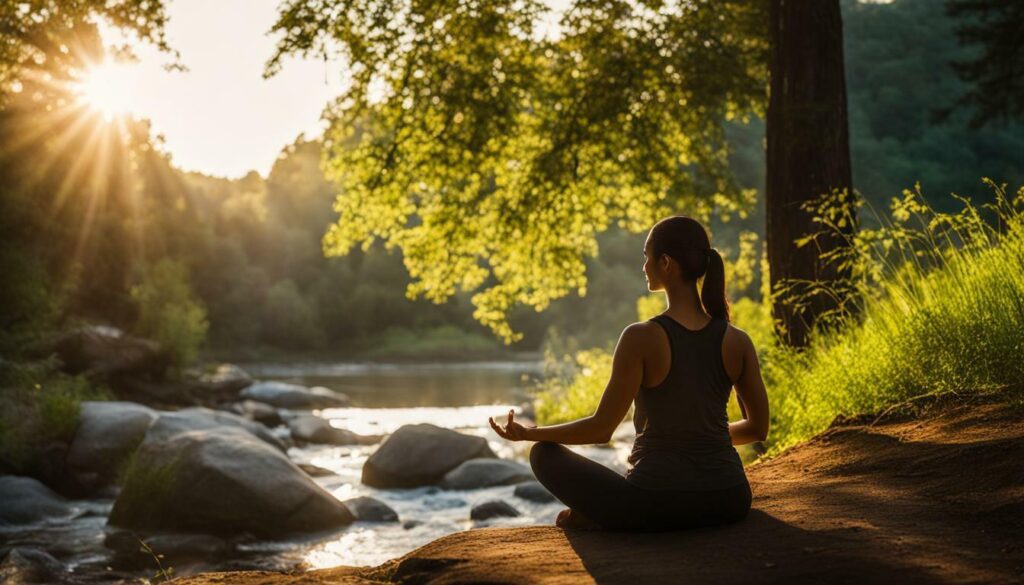
By incorporating yoga into your daily routine, you are taking a proactive step towards reducing stress and promoting overall well-being. Embrace the transformative power of yoga and make it an integral part of your life. As you continue on this journey, you will discover that yoga not only helps you find inner peace but also empowers you to face the challenges of everyday life with resilience and balance.
Conclusion
Yoga offers a powerful and accessible path to stress relief, inner peace, and overall well-being. By incorporating yoga into your life, you can experience the transformative benefits it brings. Scientific research shows that yoga activates the body’s relaxation response, leading to lower blood pressure and reduced stress hormones.
Essential yoga techniques for stress relief include gentle asanas like Child’s Pose and Standing Forward Bend, which promote relaxation and release tension in the body. Breathing exercises such as Ujjayi breath and Alternate Nostril Breathing, along with practices like yoga nidra and meditation, further enhance the stress-relieving effects of yoga.
Yoga also helps cultivate mindfulness and focus, allowing you to stay present and better manage stress and anxiety. Specific yoga practices, such as Surya Namaskar, Sthiti Dhyan, and Khand Pranayama, are particularly effective in enhancing mindfulness and bringing about a sense of inner peace.
By customizing your yoga routine to suit your preferences and needs, you can create a daily practice that promotes stress relief and mental well-being. Consistency is key, so finding a suitable time and space for practice is important. Embracing the holistic nature of yoga and incorporating it into your daily routine can bring about a profound sense of peace and balance.
FAQ
Q: Can yoga really help with reducing stress?
A: Yes, yoga is a powerful method for reducing stress. It activates the body’s relaxation response, lowers blood pressure, and reduces stress hormones.
Q: What are some essential yoga techniques for stress relief?
A: Essential yoga techniques for stress relief include gentle asanas like Child’s Pose and Standing Forward Bend, pranayama exercises like Ujjayi breath and Alternate Nostril Breathing, yoga nidra (yogic sleep), and meditation and mindfulness practices.
Q: How does yoga help with mindfulness and focus?
A: Yoga helps cultivate mindfulness and focus by keeping you in the present moment. Practicing yoga regularly can help manage stress and anxiety while enhancing mindfulness.
Q: Are there specific yoga practices that enhance mindfulness?
A: Yes, specific yoga practices that enhance mindfulness include Surya Namaskar (Sun Salutation), Sthiti Dhyan (Observation Meditation), and Khand Pranayama (Segmented Breath).
Q: How can I customize my yoga routine for stress relief?
A: You can customize your yoga routine for stress relief by incorporating gentle asanas, pranayama exercises, meditation, and mindfulness practices. Adapt the practice to your preferences and needs for optimal stress relief.
Q: Are there expert-guided yoga techniques and tips available?
A: Yes, there are expert-guided techniques and tips available for using yoga as a tool for stress relief. These may include step-by-step instructions for specific poses, breathing exercises, and meditation practices.
Q: What is the connection between yoga and stress management?
A: Regular yoga practice can help individuals develop resilience to external stressors, build emotional strength, and enhance overall coping mechanisms. Yoga offers a holistic approach to stress management.
Q: How can I incorporate yoga into my daily routine?
A: To incorporate yoga into your daily routine, find a suitable time and space for practice. Consistency is key. You can also create a peaceful and conducive environment for practicing yoga at home.
Q: Is yoga an effective method for stress relief?
A: Yes, yoga is an effective method for stress relief. By customizing your yoga practice and incorporating it into your daily routine, you can experience the benefits of stress relief and inner peace.

